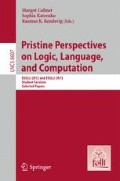Abstract
Lewis [L1] invented signaling games to show that semantic meaning conventions can arise simply from regularities in communicative behavior. The behavioral implementation of such conventions are so-called signaling systems. Previous research addressed the emergence of signaling systems by combining signaling games with learning dynamics, and not uncommonly researchers examined the circumstances preventing the emergence of signaling systems. It has been shown that by increasing the number of states, messages and actions for a signaling game, the emergence of signaling becomes increasingly improbable. This paper contributes to the question of how the invention of new messages and extinction of unused messages would change these outcomes. Our results reveal that this innovation mechanism does in fact support the emergence of signaling systems. Furthermore, we analyze circumstances that lead to stable communication structure in large spatial population structures of interacting players.
Access this chapter
Tax calculation will be finalised at checkout
Purchases are for personal use only
Preview
Unable to display preview. Download preview PDF.
References
Alexander, J.M., Skyrms, B., Zabell, S.L.: Inventing new signals. Dynamic Games and Applications 2(1), 129–145 (2012)
Barret, J.A.: The Evolution of Coding in Signaling Games. Theory and Decision 67, 223–237 (2009)
Barret, J.A., Zollman, K.J.S.: The Role of Forgetting in the Evolution and Learning of Language. Journal of Experimental and Theoretical Artificial Intelligence 21(4), 293–309 (2009)
Bloomfield, L.: Language. George Allen & Unwin, London (1935)
Bush, R., Mosteller, F.: Stochastic Models of Learning. John Wiley & Sons, New York (1955)
Franke, M., Jäger, G.: Bidirectional optimization from reasoning and learning in games. Journal of Logic, Language and Information 21(1), 117–139 (2012)
Hofbauer, J., Huttegger, S.M.: Feasibility of communication in binary signaling games. Journal of Theoretical Biology 254(4), 843–849 (2008)
Huttegger, S.M., Skyrms, B., Smead, R., Zollman, K.J.: Evolutionary dynamics of Lewis signaling games: signaling systems vs. partial pooling. Synthese 172(1), 177–191 (2010)
Huttegger, S.M., Zollman, K.J.S.: Signaling Games: Dynamics of Evolution and Learning. In: Benz, A., Ebert, C., Jäger, G., van Rooij, R. (eds.) Language, Games, and Evolution. LNCS (LNAI), vol. 6207, pp. 160–176. Springer, Heidelberg (2011)
Lewis, D.: Convention. Harvard University Press, Cambridge (1969)
Mühlenbernd, R.: Learning with Neighbours. Synthese 183(S1), 87–109 (2011)
Mühlenbernd, R., Franke, M.: Signaling Conventions: Who Learns What Where and When in a Social Network. In: Proceedings of EvoLang IX, pp. 242–249 (2011)
Roth, A., Erev, I.: Learning in extensive-form games: experimental data and simple dynamic models in the intermediate term. Games and Economic Behaviour 8, 164–212 (1995)
Skyrms, B.: Signals: Evolution, Learning & Information. Oxford University Press, Oxford (2010)
Wagner, E.: Communication and Structured Correlation. Erkenntnis 71(3), 377–393 (2009)
Zollman, K.J.S.: Talking to neighbors: The evolution of regional meaning. Philosophy of Science 72(1), 69–85 (2005)
Author information
Authors and Affiliations
Editor information
Editors and Affiliations
Rights and permissions
Copyright information
© 2014 Springer-Verlag Berlin Heidelberg
About this paper
Cite this paper
Mühlenbernd, R., Nick, J.D. (2014). Language Change and the Force of Innovation. In: Colinet, M., Katrenko, S., Rendsvig, R.K. (eds) Pristine Perspectives on Logic, Language, and Computation. ESSLLI ESSLLI 2013 2012. Lecture Notes in Computer Science, vol 8607. Springer, Berlin, Heidelberg. https://doi.org/10.1007/978-3-662-44116-9_13
Download citation
DOI: https://doi.org/10.1007/978-3-662-44116-9_13
Publisher Name: Springer, Berlin, Heidelberg
Print ISBN: 978-3-662-44115-2
Online ISBN: 978-3-662-44116-9
eBook Packages: Computer ScienceComputer Science (R0)

